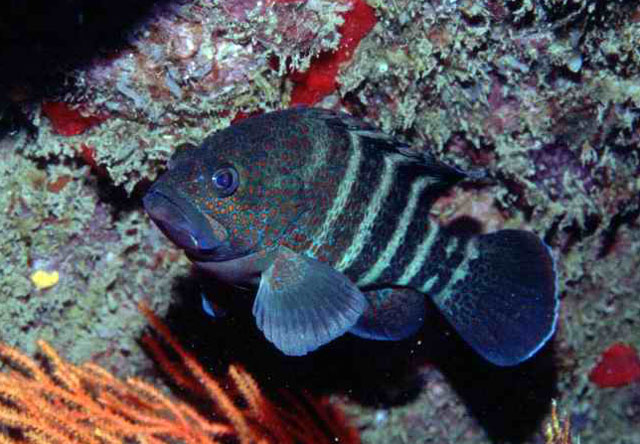| Epinephelidae (Groupers) |
| 30.5 cm TL (male/unsexed) |
|
demersal; brackish; marine; depth range - 100 m |
| Eastern Atlantic: Senegal to Lobito, Angola, including the Canary Islands (Tenerife). |
|
Dorsal spines (total): 9-9; Dorsal soft rays (total): 14-15; Anal spines: 3-3; Anal soft rays: 8-8. Diagnosis: depth of body 2.8-3.0 in SL; head length 2.5-2.6 in SL; eye diameter greater than interorbital width, eye diameter 4.6-5.5 in HL; flat interorbital area; rounded preopercle, finely serrate, lower edge fleshy; subopercle and interopercle smooth; convex upper edge of operculum; maxilla scaly, reaching well past eye; lateral-body scales ctenoid, without auxiliary scales (Ref. 89707).
Description: body robust and moderately compressed; caudal peduncle deeper than long; mouth slightly oblique, chin prominent; 1-2 pairs of upper, and 1 pair of well developed lower canines anteriorly in jaws; small ctenoid scales covering bases of soft parts of dorsal and anal fins (Ref. 57293).
Coloration: brown with dark crossbars well visible on posterior part of body, indistinct anteriorly; throat reddish; head with reddish spots enclosed in a more or less hexagonal network of dark lines; black tip of interradial membrane of the dorsal fin; caudal fin pale distally (Ref. 57293). |
| Occurs on mud (Ref. 5222), sand, and rock bottoms (Ref. 5222, 57293) in coastal waters, usually above 50 m depth (Ref. 57293). Exceptionally enters brackish lagoons and estuaries (Ref. 57293). |
|
Least Concern (LC); Date assessed: 27 March 2018 Ref. (130435)
|
| harmless |
Source and more info: www.fishbase.org. For personal, classroom, and other internal use only. Not for publication.

